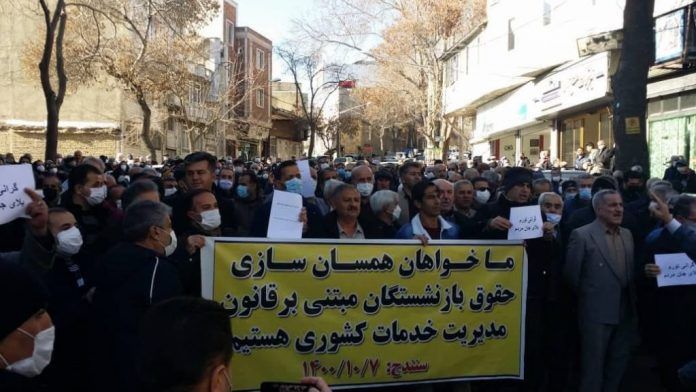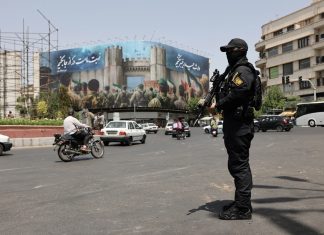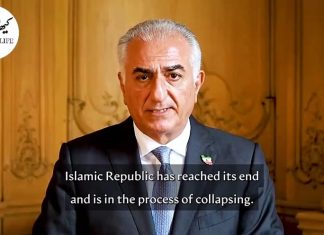By Kayhan Life Staff
Thousands of retirees held protests across the country on Dec. 28, calling on the government to raise their “meager” pensions in line with the Civil Service Management Law, inflation rate, and the cost of living index.
Footage and photographs posted on social media showed pensioners protesting outside government buildings in a dozen cities, including Tehran, Isfahan, Shiraz, Ghazvin (northwest), Ardabil (northwest), Ahvaz (southwest), Mashhad (northeast), Damghan (north) and Shahr-e Kord (southwest).
While retired government employees, teachers, workers, and others in Tehran protested outside the Majlis building (the Iranian Parliament), those in other cities gathered in front of their respective provincial Department of Pensions. They carried placards and shouted slogans, including “Retirees, make your voice heard, and demand your rights,” “People are plagued by inflation and high cost of living,” and “Teachers, workers, united.” Protesters also called for the immediate release of imprisoned teachers and workers.
The monthly payment for most retirees is between $100 and $200 (using the daily market exchange rate of 300,000 rials per dollar). In the fall of this year, an official report set the poverty line at around $400 a month for an Iranian household of three or four. Retirees’ pensions do not meet the living cost of most families, given medical, wedding, healthcare, education, and insurance expenses.
Earlier this week, footage tweeted by Kayhan London showed a large crowd of protesters in the western city of Sanandaj carrying a banner that read: “We demand that our pensions be increased in line with the Civil Service Management Law.” The date on the banner was Dec. 28, 2021.
بازنشستگان در سنندج: گرانی و تورم بلای جان مردم!
امروز سهشنبه ۷ دی ۱۴۰۰ بازنشستگان مشاغل گوناگون در شهرهای مختلف ایران علیه حقوق ناچیز و مشکلات معیشتی و گرانی دست به اعتراض زدهاند pic.twitter.com/LmP5Xwhb36
— KayhanLondon کیهان لندن (@KayhanLondon) December 28, 2021
The protesters demanded that the bill on pension increases become law (i.e. permanent) and broadened to include retirees in the fields of arts and culture. They also called on the government to enforce the existing Civil Service Management Law and raise all pensions in line with the rate of inflation and the cost of living index. Footage tweeted by Kayhan London showed protesters in Shahr-e Kord shouting: “Pensioners, make your voice heard and demand your rights.”
بازنشستگان در شهر کرد: بازنشسته داد بزن، حقّتو فریاد بزن! امروز سهشنبه ۷ دی ۱۴۰۰ بازنشستگان مشاغل گوناگون در شهرهای مختلف ایران علیه حقوق ناچیز و مشکلات معیشتی و گرانی دست به اعتراض زدهاند. pic.twitter.com/1iY8OEsmXf — KayhanLondon کیهان لندن (@KayhanLondon) December 28, 2021
Footage tweeted by Kayhan London showed protesters outside the Majlis shouting “teacher, worker, united” and “teachers are fed up with discrimination.” Others held placards that said “we stand together until victory” and “pensioners, fight discrimination.”
بازنشستگان در تهران: معلم، کارگر، اتحاد اتحاد!
امروز سهشنبه ۷ دی ۱۴۰۰ بازنشستگان مشاغل گوناگون در شهرهای مختلف ایران علیه حقوق ناچیز و مشکلات معیشتی و گرانی دست به اعتراض زدهاند. pic.twitter.com/13eFLpLY6T
— KayhanLondon کیهان لندن (@KayhanLondon) December 28, 2021
Protesters also called on the Majlis to pass the bill on raising pensions for retired military personnel and welfare recipients. The Majlis received the proposed bill three months ago but has yet to include it in its agenda. Footage tweeted by Kayhan London showed protesters outside the Ghazvin Provincial Department for Pensions shouting “amend the pension bill — and no tricks,” “retirees, make your voices heard and demanded your rights.”
بازنشستگان در قزوین: اصلاح همسانسازی، بدون حقهبازی! امروز سهشنبه ۷ دی ۱۴۰۰ بازنشستگان مشاغل گوناگون در شهرهای مختلف ایران علیه حقوق ناچیز و مشکلات معیشتی و گرانی دست به اعتراض زدهاند. pic.twitter.com/8g2RrlPoyd — KayhanLondon کیهان لندن (@KayhanLondon) December 28, 2021
On Dec. 27, the Iranian Minister of Economic Affairs and Finance, Ehsan Khandouzi, announced a plan to raise pensions by revamping the country’s insurance industry. However, retirees demand that their pensions increase in line with the cost-of-living- index and inflation rate. They argue that no insurance support package will lift them above the poverty line.
In a letter to Iranian President Ebrahim Raisi, retirees receiving social security benefits asked that their pensions be adjusted according to the inflation rate. They argued that the State Welfare Organization of Iran had to raise their pensions and benefits in line with the rate of inflation under Article 96 of the Welfare Law.
“In June 2020, the State Welfare Organization failed to increase pensions by a sufficient amount, citing lack of funds. The measure outraged many retirees receiving social security benefits,” the letter said. “Under Article 113 of the Civil Service Management Law and the amendment to the same article passed on Feb. 24, 2010, the government should have addressed issues concerning the State Welfare Organization and National Pension Funds by the end of the Fourth Five-Year Development Plan [2004-2009]. Unfortunately, this article and the amendment to it were never enforced.”
“The National Pension Funds discriminates against the State Welfare Organization. Despite Article 12 of the Sixth Five-Year Development Plan [2016-2021], the State Welfare Organization has not received what it is entitled to under the law,” the letter argued. “The previous government even reallocated part of the State Welfare Organization’s funding to the National Pension Funds.”
“According to unofficial data, one million of all the retirees receiving social security benefits were government employees on fixed-term and permanent contracts and others who worked in science, education, and research centers. These pensioners had retired under Article 103 of the Civil Service Management Law,” the letter explained. “However, the half-measures in June 2020 and April 2021 did not raise their pensions and benefits to the same level as other retirees with the same length of service. The discrepancy in the monthly pay ranges from $17 to $100 — depending on education and job title — even though retirees receiving social security benefits have contributed more to social security insurance than retired military veterans and state employees.”
“Citing the lack of funds, the State Welfare Organization used an arbitrary formula in April to increase all pensions by 75 percent. It promised to add the remaining 25 percent to all pensions in the second half of the year [April to November], but has done nothing so far,” the letter added.
Last week saw the largest ever nationwide strike by teachers in Iran. Tens of thousands of teachers marched in some 100 cities across Iran, including Tehran, Karaj (north), Shiraz, Mashhad, Rasht (north), Nowshahr (North), Sanandaj (west), and Ilam (west), demanding their rights as articulated by the Iranian Teachers’ Trade Association (ITTA). Riot police and security forces brutalized strikers and arrested three teachers in several cities.
The primary demand of teachers is for the government to implement the “Teachers’ Pay Structure Act,” which, if enforced, would raise teachers’ salaries. While the protests by teachers did prompt the Majlis (Iranian Parliament) to pass the Teachers’ Pay Structure Act, union activists argue that the salary increase was “cursory” and, therefore, that the “teachers’ strike will continue.”






